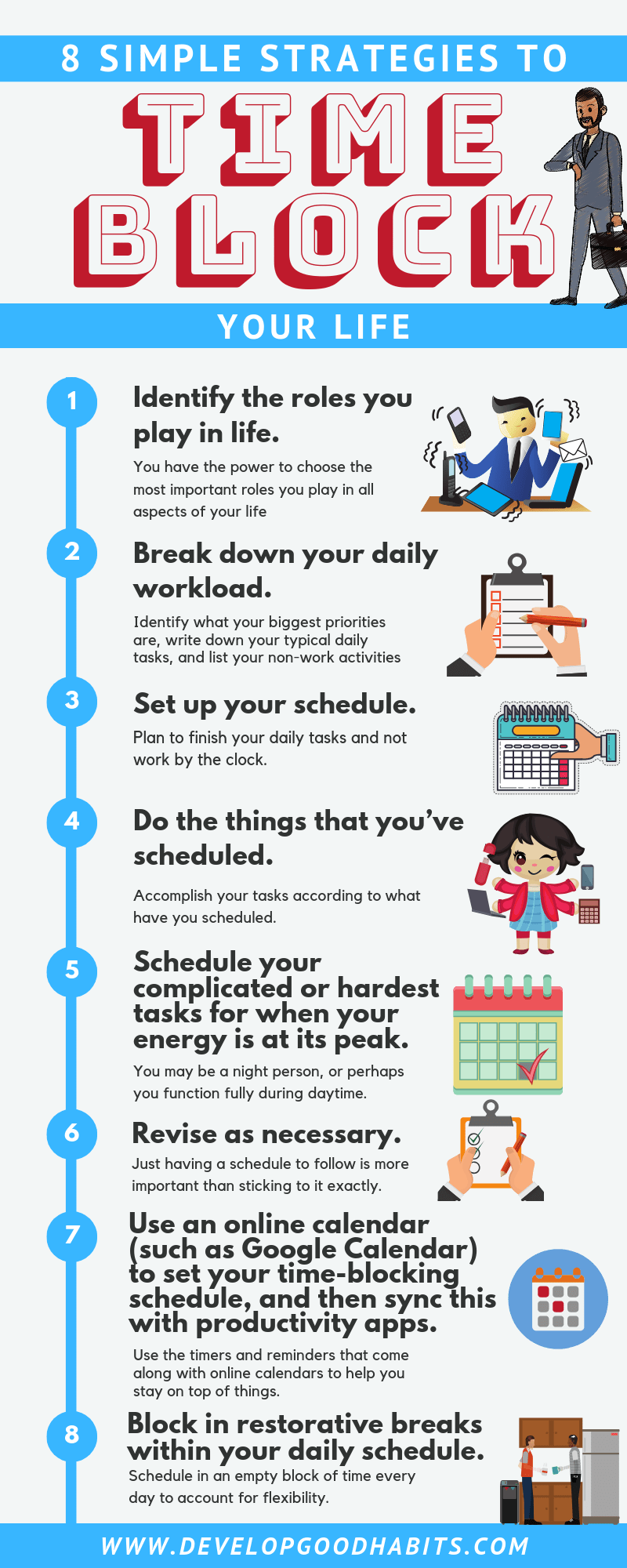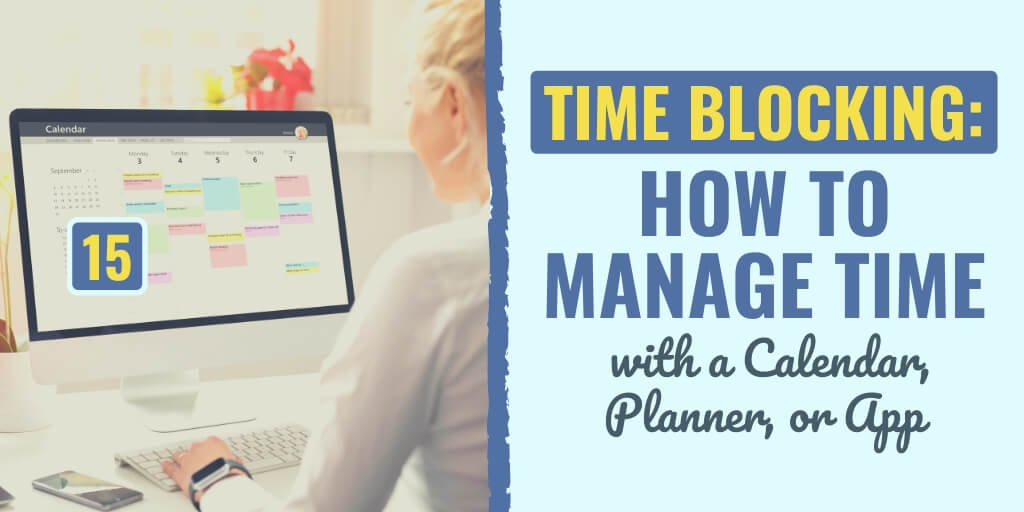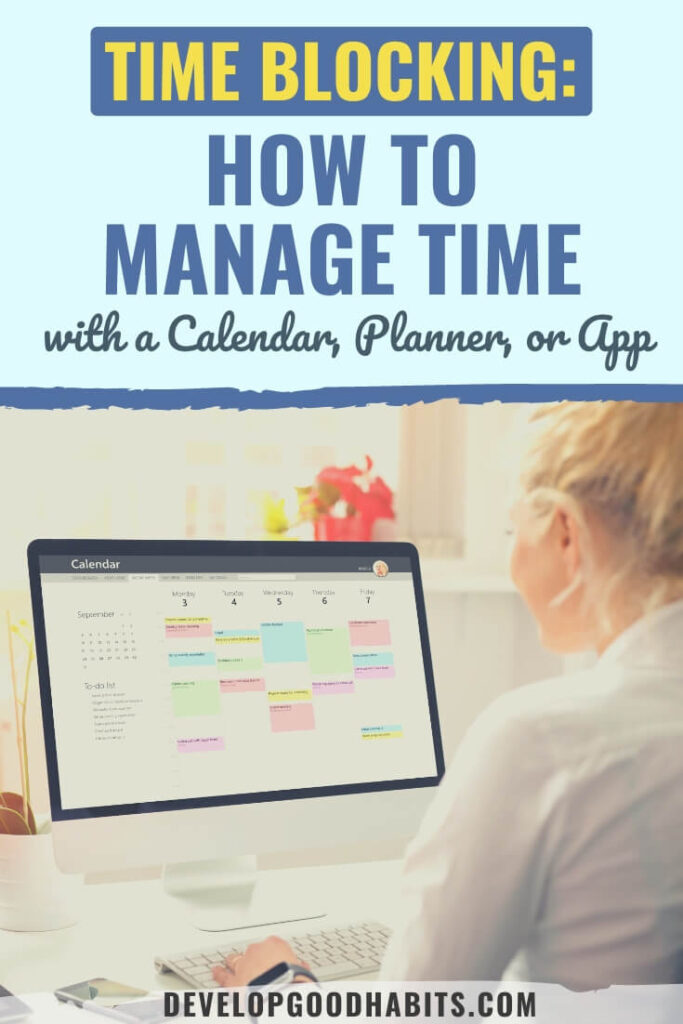There might be affiliate links on this page, which means we get a small commission of anything you buy. As an Amazon Associate we earn from qualifying purchases. Please do your own research before making any online purchase.
With all the demands on your time on any given day, how do you manage it wisely?
When it comes to time management & productivity small changes can have some large impacts on results. This is why time-blocking can be so important
Consider the following time management scenarios:
A. You stay up late yet again because a project’s deadline is the next day and you’re not even halfway done.
You fight sleep as dawn slowly approaches, putting the finishing touches on the project. You hope for a decent outcome when you present it after a couple of hours’ sleep.
B. You work for eight hours straight, taking just 15 minutes for your lunch break.
You are expected to submit an annual budget report, and you spend all the hours of the day working on just that particular task. At the end of the day you finish the report. However, you don’t feel productive enough after completing the two-page report.
C. You are an entrepreneur running an online business for the first time. You run a website, an online store, and a weekly vlog.
Things are looking up in your business, as some potential investors have shown interest. Moreover, through your work, you have several invitations to be a speaker or workshop facilitator. You are starting to feel overwhelmed, and sometimes wish you could have 30 hours in a day to get things done.
Which scenario do you fit in?
Time blocking can help you stay on track with all the things that need your attention. It helps you get things done in a way that allows you to manage your time, gives you back a sense of control in your life, centers you, and offers you peace of mind.
These days, there are apps such as Plan, WeekPlan, and PomoDone that are perfect for increasing productivity using time blocking.
There are also downloadable time-blocking templates based on specific purposes (e.g., for realtors, salespeople, and productivity managers).
In this article, we will discuss what time blocking is, explore how it benefits your productivity, and offer tips on how to manage your time with time blocking template.
First, let’s talk about what time blocking is.
What Is Time Blocking?
Time blocking (alternatively: timeboxing) is a concept of managing your time in the most organized way possible.
If you are used to scheduling your day using to-do lists, you probably find yourself frustrated at night when you haven't been able to cross every item off your list. This is because to-do lists are insufficient. They don't help you prioritize your tasks or manage your time effectively.

In time blocking, you allocate a fixed period of time in your daily schedule to accomplish a specific activity.
When used properly, this allows you to focus on accomplishing big and small tasks while not being dependent on the clock to determine how many more hours are left for you to do your work.
As a productivity tool, time blocking is very effective and has been used by people like Benjamin Franklin, Bill Gates, and Elon Musk to get things done despite their super hectic schedules.
In this six-minute video, Thomas Frank observes how Elon Musk accomplishes all his tasks on any given day with a time-management technique Musk calls “timeboxing.”
What Are the Benefits of Time Blocking?
Although time blocking is essentially a very simple concept, it adds value to a person’s collection of time-management tools.
It determines what tasks are urgent and important, and helps you keep a balance of both.
When you use time blocking, you can take care of urgent matters, and yet at the same time stay on track with your long-term projects.
When you don’t plan how you're going to use your time, you let insignificant tasks dominate your time—and at the end of the day, you realize that important things didn’t get accomplished. Even if you start working on tasks that are a priority, you may run out of time before you finish them.
Making plans ahead of time and blocking out enough time to complete all of your tasks allows you to finish the things that are most important to reach your long-term goals.
It stops procrastination in its tracks.
If a task does not make it onto your schedule, it is possible that it’s not really a priority.
We have all been guilty of delaying work, avoiding doing certain things, and procrastinating on tasks. (This is when you know there is something you should be doing, but you decide to do something else instead.)
Research has actually shown that procrastination can be avoided using techniques such as time blocking. One obstacle to starting a task that you don't want to do is the cognitive load that just getting started puts on you.
When you need to start doing something, there is a demand on your mental energy that requires you to decide what your next step is. Time blocking reduces this cognitive load because your next step is always laid out for you.
When you schedule a specific time to begin working on a task, you are more likely to actually do it because your mind is prepared to get started. You're aware of the upcoming task, and you are ready to transition into this task without hesitation.
It motivates you to act on your priorities.
Scheduling the things you need to do for the day is like attending an important meeting—you commit to showing up and accomplishing them.
Sometimes, the hardest part of working on a project is just getting started. It only takes a spark of motivation to overcome procrastination. Make the commitment to follow your schedule exactly how you plan it, and it will give you the motivation that you need to get things done.
Once you have set aside the necessary time to do the work, it will be a priority over anything else during that time. The more you are able to get accomplished using this technique, the more motivation you will generate.

Your open-loop tasks are accomplished.
This is part of the GTD idea. Open loops are tasks that need to be done but have no specified next step. Time blocking provides the answer to the question: When will I get this done?
By setting time blocks to accomplish a task, you can start ignoring trivial details, simplify all of the steps in your project, and work productively toward your desired outcome with a specific plan for success.
As you make deliberate progress with your work, you will be able to complete those projects that don't have a clear end date.
Having a lot of unfinished tasks can be draining, but if you use time blocking, you can define your next steps for every project on your calendar. This way, you can project the date you will finish.
It pushes you to have a realistic view of your time.
Time blocking lets you see the big picture of your entire day’s schedule. It forces you to give a realistic estimate of how long you actually have to accomplish your tasks.
While you might be tempted to put 10 things on your list of things to do for a day, you probably won't get every single one of them done.
By making yourself estimate the amount of time each task will take while also thinking about the other obligations you have in your life, it is tough to commit to doing too much in one day.
It allows you to be the master of your time.
You are the one who controls where you will turn your attention and chooses to take care of your tasks before entertaining distractions or requests.
People often allow their calendars to lead their days, so if something is on the calendar, it will happen. But people also their calendars as a tool to have their free time taken away, leading to long working hours due to interruptions.
If you block off important work times on your calendar ahead of time, you can use it to guide your time.
The infographic below compares the daily time management of average people and extremely productive people.
8 Simple Strategies to Time Block Your Life
1. Identify the roles you play in life.
You have the power to choose the most important roles you play in all aspects of your life. These are where your priorities lie.
This means that, just like you schedule your working hours, meetings, events, and other things, you need to schedule the things in your life that are more important in the long run to you than the things that are already on your calendar—and defend them!
For example, if you have a goal to get more fit, and that requires going to the gym, set aside that time in your calendar and don't let anything get in its way. If you time block everything going on in your personal life before you time block work, you will notice how much your work-life balance improves.
Time block your breaks and leisure time. Even time block your sleep. Put your essential needs first, and then work your professional obligations around them. Remember that you don't have to schedule everything in detail at first—just make sure that you are filling your primary roles in your life.
2. Break down your daily workload.
Identify what your biggest priorities are, write down your typical daily tasks, and list your non-work activities. The Eisenhower Matrix is a helpful system for categorizing tasks according to their importance and urgency.
Doing this will help you figure out what needs to be done in the morning, and what can possibly be pushed off to another day if it seems like your day is particularly full.
For example, if you have conference calls until 11:00 am, you can't expect to get three hours of work done on a big project before lunch. Consider all of the tasks that are involved in your day before dedicating your time to specific projects.
3. Set up your schedule.
Block your entire day. Plan to finish your daily tasks and not work by the clock. Instead, record several tasks that you assign certain blocks of time to get finished. Once you're done with your tasks, your work for the day is done.
This means that, instead of following a to-do list that has to be completed before the end of the day, you’ll have blocks of time dedicated to finishing specific projects one at a time.
For your empty blocks of time, schedule in shorter blocks (dedicating one task per block), going in order of priority. This way, you will get your prioritized tasks completed first.
Address less-complicated tasks toward the end of the day, when you’re worn out and not feeling too productive. These more mindless tasks may include answering emails and calls.
Everyone's time-blocking schedule looks different—it just depends on your personal priorities.
4. Do the things that you’ve scheduled.
Accomplish your tasks according to what have you scheduled. View the blocks with respect, and do not do tasks that are not part of a scheduled block.
It is important to commit to time blocking in order to make it effective. It might feel rigid at first, but giving it time will help you see its benefits, and see whether it helps you be more productive with your time.
Part of being committed to the process is avoiding outside distractions when you are in the middle of one of your time blocks. Focus only on the task at hand. Put your phone on silent, eliminate background noise, and turn off email and social media notifications.
While other people can be potential distractions, you are actually your own worst enemy when it comes to getting off track. You pose more of a threat to your own attention than other people do.

5. Schedule your complicated or hardest tasks for when your energy is at its peak.
You may be a night person, or perhaps you function fully during the daytime. Either way, make sure to block time for your most difficult tasks when you’re most productive and energized.
For most people, this is in the morning before their work for the day starts to get overwhelming. Dedicate at least an hour to your most complicated task. Start with this one, and then move on to your next time block, which should be your second-highest priority.
For example, if you are at peak productivity first thing in the morning, plan to spend that time block on your hardest task, no matter how far in the future it is due. Remember, time blocks typically aren’t effective if they exceed a few hours in length.
6. Revise as necessary.
Things will not go as expected 100% of the time. At the end of the day, review how things went with your time blocking and make revisions to your schedule as necessary.
Your time blocks are ultimately a guess as to how your day will end up playing out, and rarely are they 100% accurate. Sometimes things take longer than you anticipate, or a last-minute crisis wipes out your entire day. That's ok. Just having a schedule to follow is more important than sticking to it exactly.
To help your time blocking be successful, you should let other people know about it so they can respect your working preferences. Consider sharing your time-blocking schedule with coworkers or family so they know what that can expect from your workday.
While you can't expect everyone to plan around you, sharing your time blocks will help prevent scheduling conflicts for someone you work or live with.
Of course, even if you share your schedule with everyone, things will inevitably come up. While you should stick to your time-blocking schedule as much as possible, be open to making adjustments as your goals change or unexpected things come up.
In this six-and-a-half-minute time blocking video, Jason Whaling provides tips on how you can easily start incorporating time blocking as a habit in your life. The tips include:
7. Use an online calendar to set your time-blocking schedule, and then sync this with productivity apps.
Especially when you are just beginning practicing time blocking, it may be difficult to keep track of the various blocks that you set for yourself. Use the timers and reminders that come along with online calendars to help you stay on top of things.
Also, keep track of your productivity through an app, such as Todoist. (Here's our Todoist tutorial to help you get started.)
Time blocking may not be the answer for you, but you will only know that if you are following your progress. Make sure it is working for you by seeing if your productivity increases once your calendar is organized this way.
8. Block in restorative breaks within your daily schedule.
Schedule in an empty block of time every day to account for flexibility. You can just start with half an hour and increase this as needed.
Use this time for tasks that overflow beyond their time limit, or unexpected interruptions that have to be dealt with right away.
To better manage these “rest” blocks, use the Pomodoro technique. Watch the video below to learn more.
The purpose of time blocking is to develop a directed and focused flow of work for your day so you can be productive—not to make you feel like you have one task right after the next, and that you're running yourself into the ground.
Breaks are necessary, and if you don’t add them to your schedule, you are likely to take them at some point anyway (which might make you feel guilty because it’s not what you are “supposed” to be doing). Try scheduling in 5- 15-minute breaks between blocks, and an hour for lunch.
Also, schedule in personal time to spend with your loved ones every week. Block off time for vacations and other things that you need to do to restore yourself.
Self-care is important and should be made a priority in your life. If you don't take care of yourself first, your work will not be done at an optimal level.
Infographic Recap
Looking for strategies to time block your life? Read this infographic below to know more about time blocking and how it can improve your life.

Final Thoughts on Time Blocking
We’ve learned that time blocking is an effective productivity tool. It creates peace of mind and frees you from feeling overwhelmed with all the things that you need to accomplish.
The suggestions on how to manage your time using time blocking serve as a way to increase your productivity and develop an organization system for your work and life.
When using time blocking for the first time, templates, planners, online calendars, and apps are helpful for keeping track of your daily schedule. Use time blocking for one day of the week when you are still starting out.
And if you're looking for more resources to help you achieve success in your career, be sure to read these blog posts:
- 23 Good Work Habit Examples to Build a Successful Career
- 7 Career Goal Setting Worksheets
- 11 SMART Goals Examples for Growing Your Career
Finally, if you want to level up your productivity and time management skills, then watch this free video about the 9 productivity habits you can build at work.



Pomodoro technique anyone?
It’s by far the best productivity hack I’ve ever tried and I’ve stuck with it for years now because of how effective it is.
I usually have a couple of projects going on at the same time.
So what I like to do to keep things interesting while not feeling overwhelmed by everything is by doing rotations.
Work on Project A for 25 minutes.
Take a 5-minute break.
Work on Project B for 25 minutes.
Take a 5-minute break.
Work on Project C for 25 minutes.
Take a 5-minute break.
Then I’ll start back at Project A.
That way, I’m putting in almost an equal amount of effort for all my projects while being able to stay sane.
And it’s been working so well!